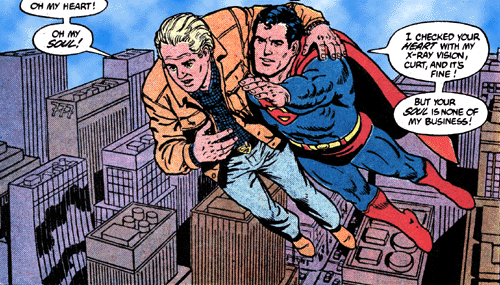
|
|
|

CURT SWAN: A LIFE IN COMICS
(Skip ahead to the part about Superman)
I dropped by the Smithsonian when I was in Washington one day this
past June to see the new Superman exhibit. Like other Americans who
will visit the museum during the exhibit's year-long run, I have a
certain fondness for the Man of Steel. He and I go back a long way.
For 30 years or so, from around 1955 until a couple of years ago when
I more or less retired, I was the principal artist of the Superman
comic for DC COMICS.
It still surprises me sometimes when I think about it. It was never
something I set out to do. It just kind of happened, the way a lot of
good things do. In fact, if anybody had told me when I was a kid
growing up in Minneapolis back in the '30s that I would one day be
sitting on the set of something called The Today Show being
interviewed about my work by a young woman named Jane Pauley, or that
I would be a guest celebrity at a national comic-book convention, I
would have thought he or she was crazy. Television was still only
Science Fiction in those days, and, not only wasn't I much interested
in Science Fiction, I wasn't even particularly into comic books.
My brother Stanley - I was the youngest of five children, and he was
the oldest - was an avid reader of the "pulps." But I preferred
curling up with magazines like Collier's or the Saturday
Evening Post. I especially liked the adventure stories - I guess
because of the illustrations. I was already drawing my head off every
chance I got, and I was in awe of those illustrators. I admired their
technique, their coloring, their composition, their honesty with the
human figure. It was my dream that I would one day be an illustrator,
too.
My teachers had recognized my talent early. They were always giving
me projects to do, such as calling me up to the blackboard to draw a
mural or illustrate some lesson. I remember a school fair we had when
I was in sixth grade. Every child in the school was expected to do a
project to be sold (I don't remember what they were going to do with
the money). I got the idea of doing a comic book. It was a takeoff
on those Big Little Books that were very popular in those days, which
I discovered while babysitting for a younger child in the
neighborhood. They were fat little paperback books that contained
reprinted comic strips. So I got hold of a desk calendar - the kind
with the big numerals on one side and nothing on the other - and I
stapled together a whole year's worth of them to make a blank comic
book. It was just about the right size. I wrote the story myself.
It was about two young boys who ran away from home and the adventures
they had. One of the other kids bought it. I was thrilled.
But it still did not occur to me that I might someday make a living
drawing comic books. I had more serious ambitions.
My family were serious, hard-working folk of swedish stock. (Our name
was originally Swanson, but some ancestor of mine, my grandmother, I
think, decided to shorten it.) My father, John Swan, was born on a
farm just across the Canadian border, in Saskatchewan. Later, he and
his family moved back to Wilmer, Minnesota, a town about 60 miles from
Minneapolis where the Swansons had originally settled before moving
north. My mother grew up in a nearby town called Litchfield. She was
a Hanson. Leotine Hanson. She worked for a while in a local
hospital; my father was a railroad man. He repaired trestles.
We were raised Presbyterians, but my father could never quite make up
his mind on a religion. I guess he was looking for something - or
driven by something: the fear of the unknown, perhaps. He would drag
us to a Methodist church one week, a Baptist church, the next. Since
I was the youngest, he latched on to me and always took me along with
him. I was a very religious person up until the age of 11 or 12, when
my brother Lloyd and I began to lie on the grass out under the stars
on long summer evenings, just talking about everything, deciding what
we thought about things. I sort of lost interest in churches around
that time. My brother was quite a philosopher.
This was during the depression. My family was lucky. Most of us were
able to get work of some kind, and we all chipped in to put food on
the table and paid for our own clothes. I got a job with a small
letter service doing stencils and deliveries and helping out the
printer. I also worked for Sears Roebuck for a short time as a
"warehouse man." I remember getting a letter in the mail - I must have
been about 17 - informing me that I had received a triple-A credit
rating. I was proud as a peacock!
It was around this time that I signed up with the National Guard,
along with some of my friends. The war in Europe was heating up, and,
somewhere around the end of 1940, a bunch of us were inducted into the
army - 34th Division, 135th Infantry, Service Company - and moved to
Camp Clayborn in Louisiana. We went from there to Fort Dix. I was
made a sergeant. And the following February, we boarded a ship for
Belfast, Northern Ireland. I was stationed at Fintona, near
Enniskillen, for about three months. It was there in Northern
Ireland, with a war on, that I got my first break as an illustrator.
I met a young GI named Dick Wingert, who was a cartoonist with the
army paper, Stars and Stripes. (He later created a strip
called Hubert, which was one of the most successful comic strips
to come out of World War II.) We became quite good friends while the
two of us were doing murals for the Red Cross club in Belfast, and he
suggested that I write to a Colonel Llewellyn about a position on
Stars and Stripes. I hung back, not thinking of myself as much
of a writer.
Then one day as I was dishing out grub to the headquarters staff back
at camp - I was officially a mess sergeant in those days - I got this
brainstorm. I went to another one of the guys on the staff who was
very good with words, he was some kind of writer, and told him what I
had in mind and asked him if he would script it for me. He did, and I
sent Colonel Llewellyn an illustrated letter with a silhouette of him
- I had no idea what he looked like - interviewing me and a caricature
of myself giving him my resume. The next thing I knew, I was being
shipped to London where they made me a staff artist on Stars and
Stripes. I did illustrations for the magazine section, war maps
showing the progress of the Allies, cartoons, little spot drawings for
the sports section - whatever they threw at me.
My unit, back in Belfast, was eventually shipped out to North Africa.
After the war, when we got together back in Minneapolis and they
talked about their experiences, I was very reticent to join in. They
had gone up through Italy, through the worst of it. A lot of our
friends were lost.
There was one night in London, however, when my life did flash before
my eyes. I was living in a lovely, upper-middle-class neighborhood at
the time on the outskirts of London, not too far from Henley Airport,
which was probably the reason the Germans had us on their clipboard
back across the channel where they were launching the V2s they'd
started sending over after the buzz bombs. I had been up most of the
night working on a war map and had finally gotten to bed about four or
five in the morning, when suddenly I sat bolt upright, listening. I
must have heard it deep in my sleep, the way you do with some things.
A moment later the V2 came roaring in and hit very close by, rattling
everything to hell. That was about the closest I came during the war
to meeting my Maker some years ahead of schedule.
For a year or so I roomed with Wingert in London. We were the
original Odd Couple. We originated the concept. He was Mr. Filth and
I was Mr. Clean. But we had a swell time going to the neighborhood
pubs and conversing with the citizenry on all manner of subjects -
politics, culture, the Americans versus the English. I did a mural
for an airbase somewhere in the Midlands. I was a wonderful couple of
years, except for the bombs.
Wingert and I used to go down to the Red Cross Club in London, the
Eagle Club I think it was called, to play ping-pong and eat doughnuts.
They had comic books spread out on the coffee table, and I remember
thinking, "Why would anybody want to put that much work into drawing -
for a comic book?" I couldn't imagine anybody wanting to do that for
a living.
One day word came through that Stars and Stripes needed a staff
artist in Paris. Next thing I knew I was living in a little apartment
near the Eiffel Tower. I would sit for hours sketching by the Seine.
Once I stowed away (with the complicity of the French drivers) aboard
a quarter-ton army vehicle filled with copies of Stars and
Stripes bound for the GIs at the front - to drop in for a surprise
visit on my bride-to-be, Helene Brickley, whom I'd learned was
stationed just across the Belgian border with the 82nd Airborne, the
paratroopers who had moved in ahead of Patton's army. We had met back
at Fort Dix, New Jersey. Her family lived in a nearby town and she
had come up for one of our dances. She was working for RCA in Camden
at the time. Later she had signed up with the Red Cross and turned
up, much to my surprise, in London. But when I walked into the
dispatcher's office that day in Belgium wearing a raincoat and
garrison cap, she nearly fell off her chair. The next time I dropped
in, she was living with a French family in a village nearby. We were
married in Paris in 1944.
After the war, we agreed that my chances of finding something in the
art field were greater in New York than back in Minneapolis. Several
other ex-staffers from Stars and Stripes were living in New
York, and we all used to get together at a little place on Third
Avenue called the Campus Restaurant, which is long since gone. This
was 1945. One of them was a fellow named France Herron, whom I'd
known as a feature writer on the Paris Stars and Stripes.
Before the war he'd been working in the comic-book business, and now
he was back at it, writing for DC COMICS. He suggested I take my
samples around to see Whitney Ellsworth and
Mort Weisinger at DC. I
shrugged and decided I'd give it a try.
They started me out on a Jack Kirby feature called Boy
Commandos. "Well, this will be good for about two years," I told
my wife. I figured the comic-book business hadn't much longer to run.
I was being paid $18 a page. That didn't sound too bad at first until
I discovered how much time it took me to do a single page. I was
getting really discouraged until one of the guys in the inking
department took me aside and gave me a few tips. In the comic-book
business, I had quickly learned, almost everybody specializes. There
are pencillers, and there are inkers, who turn the pencils into
finished pages, which are then turned over to the letterers and
finally the colorists. Not everybody has a style of inking that is
appropriate to comic books. Some people are very good at it and very
fast. They have to be to make any kind of living at it. In those
days the inkers were making even less than the pencillers, about $14 a
page. (The writers, I would later discover, were only getting between
$8 and $11 a page, depending on the quality of the writing.)
Anyway, this inker's name was Steve Brody. And he told me I was
putting too much work into each panel and that he was breaking his arm
inking my stuff. He showed me ways to fake things, to suggest things
without putting in every last detail. After that I was able to work
much faster. Soon I was turning out three to four pages a day. At
the end of one year I discovered I had earned almost $10,000. That
was a lot of money in those days. When a friend of mine from
Minnesota heard I had made that much, his eyes bulged out and he said,
"God! If I was making $10,000, I'd feel wealthy!"
We were living in the Rockaways then, out on Long Island, not far from
the old Floyd Bennet Field. We lived only half a block from the
beach. There was a boardwalk and we would go for long walks on the
beach. We were putting away every dime we could spare to buy a little
farmhouse in New Jersey.
But I was knocking myself out to make that much money - working up to
14 and 16 hours a day, seven days a week. They had me working on a
variety of features: Besides doing Boy Commandos, I was now
doing Tommy Tomorrow and a thing called Gangbusters. I
even did some Superboy covers - whatever they pulled out of the
drawer. I would come by the DC offices with my pencils and pick up a
new script. (The offices were on Lexington Avenue then.) At home I
had my studio set up in the bedroom or, later, when we got a big
enough house, in a separate room. If the story was difficult or I got
excited about it, I would work until three or four in the morning. I
would usually have music on or sports or maybe a talk show. I liked
the Big Bands - Charlie Barnett, Benny Goodman, Glenn Miller - and
occasionally I would tune in a symphony concert.
I worked three times up (that is, three times larger than the drawings
would eventually appear). The script usually included a description
of what was supposed to be happening in the panel, as well as the
dialogue that went in the balloons. Most of the time I was free to do
what I wanted insofar as the scene itself. Only occasionally would a
writer suggest a "long shot" or a "closeup." The only other
limitations in those days were that you shouldn't show blood or
extreme violence and should keep it cool on the sex part.
So I would compose each panel as I saw it, trying to make it
interesting and visually balanced. I would sketch in the balloons,
too, and the lettering. Most stories in those days ran ten or 12
pages. When I was finished with a story, I would take it back into
the city and lay it in front of my editor - usually Mort Weisinger in
those days. He would frequently ask me to make changes. He didn't
like the way I had some character's face or the way I had carried out
the "stage directions" in the script. Weisinger always thought you
were just goofing off. It drove me crazy. Occasionally a writer
would set a scene, say, on Fifth Avenue and want you to show the
crowded street and sidewalks literally, all the cars and the people.
Stadium scenes were especially hard to fake convincingly.
At home I was getting more and more tense, throwing things around the
room - paper, my art supplies - because I was being asked to draw
things I didn't think would work. I was working too hard, anyway. I
would get these terrific migraine headaches where I would have to lie
down on the bed, and heaven help anybody who dropped a pin. I figured
my eyes were going. I got new eyeglasses, but it didn't seem to help.
I decided I would have to give up the comic-book business and find
something less strenuous.
I took a job with a small advertising studio. (This was sometime
around 1951.) It was actually enjoyable. They handled a line of toys
and some other things. I worked on displays and occasionally jobs for
other clients. But I was making only $50 a week. My wife panicked
when I brought home my first paycheck. I panicked, too. We had just
bought a house in Tenafly, New Jersey, and had payments to make. So,
after only one month at the agency, I went back to DC. They welcomed
me with open arms.
But soon I was lying in bed at home again with a splitting headache.
Suddenly it hit me. I had had no headaches during the months I had
worked for the studio. It was not my eyes, after all. It was
something about working for DC COMICS that was causing my headaches.
So I sorted it out and decided it was Mort - or, more likely, a
combination of Mort Weisinger and myself, the way I was reacting to
his criticisms and demands, swallowing a lot of my anger. I decided
the only way to deal with it was to dig in my heals and fight him
every inch of the way. It worked. My headaches stopped for good. I
also think he respected me more after that, because I fought back. In
time, we actually became quite close friends.
I didn't have any conscious models for Superman. I suppose I may have
been somewhat influenced by Johnny Weismuller. I had always been kind
of fascinated, as a boy, by the Tarzan newspaper strip and the
Weismuller movies, and I guess I may have imitated then subconsciously
to a degree. Alex Raymond's strip Rip Kirby was probably also
an influence.
At one point in the '50s, I gave some thought to making Superman look
more like
George Reeves,
the actor who played him on television. I
had seen Reeves once on the set, briefly, on one of my trips to the
coast. I began to study his features on the TV show, but finally
decided that it would be pointless to copy him too literally, though I
think I did get his profile a little bit from time to time.
I wanted to show strength, of course, and ruggedness. And
character. He had to be the kind of person you'd want
to have on your side.
When I drew Clark Kent, on the other hand, I deliberately softened his
features, made them less angular than Superman's. I wanted him to
appear more meek. Just sort of a good Joe. I don't know if it
worked, but that's what I was trying to do.
Superman's hair was different from Clark's, too, of course. That curl
would come down - it was a way of showing action. I guess that had
been Shuster's idea: action causing that lock of hair to fall out of
place. As for Lois, I just tried to draw her pretty, but I wasn't
successful enough for Mort Weisinger. From time to time, he would
have Kurt Schaffenberger do Lois.
We also had arguments about showing expression. I felt it was
necessary to put lines in the face to show pain or whatever. Mort and
I had long discussions about this. He thought they made Superman look
too old. I think I finally got through to him by pointing out that
even a baby, when it's angry or crying, has lines in its face.
I also used to argue about some of the things the writers came up
with. I thought it was rather ridiculous that this character could do
anything the writers could dream up, like fly in space or withstand an
atomic blast. "If he's that invulnerable, then where's your story?" I
used to ask. But I guess they thought of me as just that stupid
artist. Eventually, they had to invent things like all the
different-colored
kryptonite,
which seemed to me a feeble way of
getting out of the box they had put themselves in.
Once in the early '50s, I decided to take a course in illustration. I
wanted to improve my craft. I had been more or less self-taught. So
I enrolled at Pratt Institute in Brooklyn. Some of the teachers
raised their eyebrows when they heard what I did for a living, but my
fellow students, who were mostly attending art school on the GI Bill
and still trying to break into the business, were a little bit in awe
of me. It turned out to be just a review of everything I already
knew. It was a long drive in from New Jersey two nights a week at the
end of a long day, and I began to find myself nodding off on the way
home. So after a few months, I gave it up. So much for my formal art
education.
The comics, I decided, were not a bad place for an artist to make a
career, after all. Where else could you have the fun of creating an
entire city in a bottle? I think Al Plastino had first drawn
Kandor,
the Kryptonian city that had been miniaturized by the villian
Brainiac
and thus escaped the destruction of Superman's native planet. But I
had a lot of fun inventing all that tiny futuristic architecture, not
to mention the view from inside the bottle - with the "giant" figures
peering in. I've always regretted that Al Plastino and I never got to
play golf together, another passion that we shared.
And it was always a special treat for me when the writers would come
up with a story about Mr. Mxyzptlk. Suddenly, there in the midst of a
fairly realistic comic book, was this wacky cartoon character. They
excused it by explaining that he was from the fifth dimension, of
course, and that suited me to a T, because they would go off the edge
with some of those plots, and I knew I could have a ball. It was
always like vacation time for me to get a script with Mxyzptlk.
But my favorite villian was Brainiac. I could do things with him -
his expressions, et cetera - that were tough to do with some of the
other villians. Lex Luthor, for example, didn't look evil. He
was just a bald man. You could put a scowl on his face, and he still
wouldn't look evil enough. But Brainiac was thin, even gaunt, you
could see the bone structure of his face. And there's a lot you can
do with that to make a person seem more evil. Then, of course, there
were those electrodes on his head!
But I guess the story I'm
proudest of is the 1973 version I illustrated of
"The Origin of Superman" -
showing the last days of Krypton, the baby Kal-El
rocketing to earth and being found in a cornfield by Jonathan and
Martha Kent, then young Clark discovering his superpowers as a boy and
going off to Metropolis to serve the world as Superman.
Carmine
Infantino did the layout on that story, planning the way it was to
unfold, panel by panel. It was so good. We included it in The
Amazing World of Superman, one of those special large editions we
put out for $2 a shot while Infantino was publisher. I am very fond
of that one.
Nelson Bridwell did the dialogue, and Murphy Anderson inked my pencils.
Murphy's inking was among the best. George Klein's was pretty good,
too. But since this one's for the history books, I'll have to say
that my absolute favorite among all the inkers who ever worked on my
stuff was Al Williamson, with whom I
collaborated
just before I
officially retired. He was the best. A fine draftsman in his own
right, an extremely talented artist, he could render even the little
mechanical parts of vehicles. He had a very special flair the others
didn't have.
I've worked with some inkers over the years who did not delineate the
figure of Superman the way I'd done it in the pencils. They would
lose something in the face, the eyes; the features would be just a
little off or the muscular structure. It used to get to me. I would
have to remind myself, sometimes, that this was only, after all, a
comic book and wasn't going to be hung in some gallery. I have inked
my own work, of course, back when I was working on Stars and
Stripes, but my style of inking wasn't right for comic books - a
little too ornamental. It would take me too much time, and inkers, as
I've said, have to work fast to make any money. Fellows like Al
Williamson and Murphy Anderson are all the more amazing when you
remember that.
The colorists have come a long way, too, since I was starting out in
the business. By and large, they always did a nice job. But they
were restricted in the old days by what the editors down the hall
thought made sense. Those guys believed that a sky had to be blue, so
it was blue. It was a long time before the colorists were allowed a
little creativity: now, if they want to put a red sky in, they can
put in a red sky and even make judgements about the overall treatment
of the page. And, as a result, the coloration has improved
tremendously.
I guess I was pretty far off base when I predicted, back in 1945, that
comic books were only a passing fad and would never survive the '40s.
As it turned out, the business was to be pretty good to me.
Joe Shuster was a very shy, introverted person. It always struck me
as kind of unusual, since most of the artists I know are extroverts.
I believe Joe was living somewhere out on the Jersey shore at the
time. His eyes had gotten very bad. I don't know how he supported
himself. They were a couple of sweet guys.
I found myself thinking of all of these things, and of these people,
after I came back from Washington and the Smithsonian's exhibition.
There had been some beautiful displays - blowups of Superman, one of
the costumes George Reeves wore in the TV series, a dress of Lois
Lane's and lots of other artifacts and comic books - including about a
dozen covers I remember having done.
Nice memories.
It was around this time
that I started filling in occasionally for
Wayne Boring, the artist who had taken over Superman from Joe Shuster.
But it wasn't until around 1955 that I became the primary Superman
artist. The first 3-D comics were making their appearances around
that time, because of the success of 3-D movies, I guess, and DC
wanted to get a 3-D Superman book out in a hurry. So Boring
and Al Pastino and I were all brought on to the project.
We only put out
one 3-D Superman, but Weisinger was quite happy with my
work on it, and soon after that he put me on Superman steady.
I had done Superboy and Jimmy Olsen before I did
Superman, so I was quite familiar with the characters. I used
to study Wayne Boring's work. I liked his style. I thought it suited
Superman. Wayne had a real feeling for him, the way he constructed
the figure, the flying, et cetera. Joe's Superman had been different.
He was not trying to be realistic. His conception of the character
was more cartoon-like. And my own style was was different from
Wayne's, just as Wayne's was from Joe's. I don't think any of this
was intentional; each artist just had his own way of drawing.
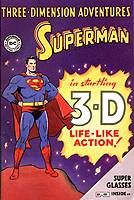
Mort Weisinger told me early on that he wanted to soften the jaw line
that Wayne Boring had put on Superman. I guess it had been Wayne's
way of showing strength and power. Mort wanted the drawing to be more
illustrative and less cartoony, maybe a little more handsome, with
more emphasis on the muscles. I did speak briefly to Wayne Boring
about it when I took over drawing the syndicated Superman strip
in the late '50s or early '60s, a couple of years before they killed
it. He knew how difficult Weisinger could be on the subject of
Superman's looks. "Just hang in there," Wayne told me, "and don't
take any s---."
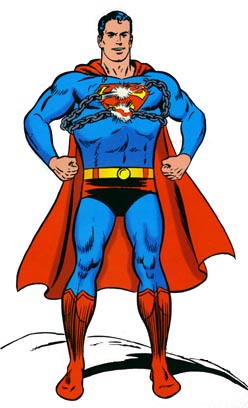
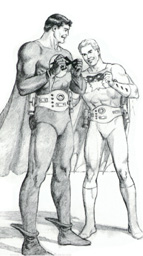
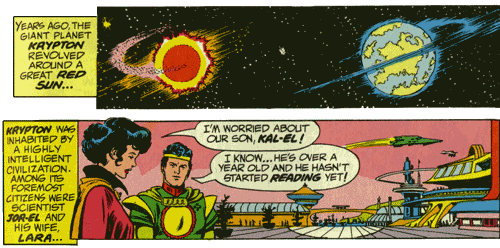
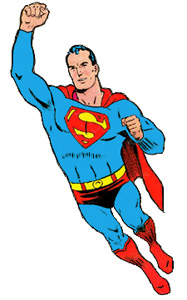 I've felt fortunate to be associated with Superman over so many
years. I've met and had the opportunity of working with some
wonderful people. I especially remember meeting Jerry Siegel and Joe
Shuster, the creators of Superman. I used to see Jerry around the DC
offices in the early '60s. This was years after their formal
relationship with DC had ended, of course, but he was often there in
those days, anonymously scripting stories about Superman and the other
characters he and Joe had created. He was soft-spoken, a very likable
person. I didn't know him socially, but I ran into him often in the
offices.
I've felt fortunate to be associated with Superman over so many
years. I've met and had the opportunity of working with some
wonderful people. I especially remember meeting Jerry Siegel and Joe
Shuster, the creators of Superman. I used to see Jerry around the DC
offices in the early '60s. This was years after their formal
relationship with DC had ended, of course, but he was often there in
those days, anonymously scripting stories about Superman and the other
characters he and Joe had created. He was soft-spoken, a very likable
person. I didn't know him socially, but I ran into him often in the
offices.
